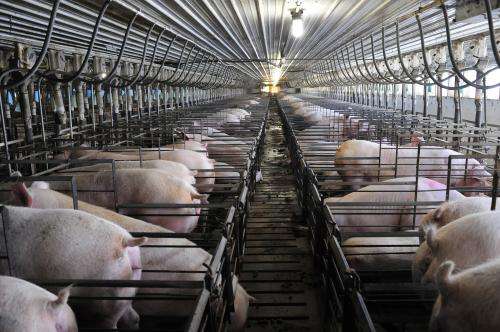Research sheds light on feed efficiency in pigs

Research conducted at Iowa State University is dispelling myths about the practice of breeding pigs to improve feed efficiency, a measurement of how well swine convert the feed they consume into mass.
Breeding for feed efficiency has drawn criticism in the past due to concerns that it produces animals more susceptible to stress and disease, but research at Iowa State conducted over the course of 10 generations of pigs questions the validity of those concerns.
"There's been some reluctance to breed for feed efficiency because of the notion that pigs that are very efficient run into difficulty if they're stressed," said Jack Dekkers, a Distinguished Professor of animal science. "We found that's not the case. If anything, more efficient pigs are also more robust."
The value of the research lies in the cost of feeding pigs, Dekkers said. Paying for feed eats up more than half of a producer's budget, and, with the memory of sky-high corn prices still fresh in the minds of many, increased feed efficiency provides a way for farmers to save money on one of their biggest expenses.
The research has the potential to lower the cost of pork production, which would benefit one of Iowa's key industries and consumers at the same time, said John Patience, a professor of animal science.
"The idea is to produce more pork on the same amount of feed," he said. "That lowers production costs, and consumers will see lower prices for pork at the grocery store."
Patience is leading an effort funded by a five-year grant from the USDA Agriculture and Food Research Initiative to develop a greater understanding of feed efficiency and transfer the findings to the pork industry. The collaborative effort involves 19 scientists – many of them at Iowa State – from a range of disciplines such as nutrition, statistics, genetics, meat science and microbiology, Patience said.
Shedding light on untested assumptions
Dekkers began studying feed efficiency in pigs in 1997. Starting with a population of Yorkshire pigs, Dekkers began breeding two distinct genetic lines. One line was bred for increased feed efficiency, while the other line was bred to be less efficient.
Using transponders attached to each pig and specialized electronic feeders, the researchers tracked the amount of food consumed by each individual. Today, the experiment is in its 10th generation with around 60 litters produced each generation in each genetic line.
Dekkers said the wealth of data gathered over the course of the long-term selection experiment has helped the team answer some of the questions pork producers have raised about the pros and cons of feed efficiency. In the current generation, Dekkers said the line of pigs bred for higher efficiency requires around 15 percent less feed to reach market weight than the line bred for less efficiency.
He said the research indicates that pigs from the feed-efficient line are better than less efficient pigs at directing their body weight reserves to where they are needed. That means that feed-efficient sows, for instance, dip further into their fat reserves during lactation after giving birth, resulting in sharper weight loss, Dekkers said. But they also replenish their fat reserves quickly after they're done nursing piglets.
The researchers found no evidence that feed-efficient sows produce smaller litters or struggle to nurse their young, a common concern about feed efficiency, Dekkers said. And the feed-efficient line fares no worse than other pigs when faced with disease, he said.
The physiology of feed efficiency
Nicholas Gabler, an associate professor of animal science, studies the physiological characteristics that make some pigs more feed efficient than others. Gabler said ISU researchers have identified a number of factors that contribute to efficiency.
"There's no single gene that controls feed efficiency," he said. "It's actually lots of things that interact and intersect. There's no silver bullet."
A big part of the puzzle has to do with the rate at which a pig can deposit and retain lean muscle, Gabler said. Feed efficient pigs spend less energy building muscle mass, and the proteins that make up their lean mass lasts longer before it has to be replenished with new proteins, he said.
The improved lean muscle deposition could potentially come at the cost of tougher meat, Gabler said. So far, that hasn't been a problem, he said. In fact, meat scientists have shown that the more efficient pigs produce pork of equal or better quality.
Additionally, feed-efficient pigs also display improved digestibility, which means they capture a greater portion of the nutrients present in their feed, Gabler said.
Behavioral tests
Jessica Colpoys, a graduate assistant in animal science, is studying the feed-efficiency lines for behavioral signs that the pigs from the feed-efficiency line are more prone to stress. So far, Colpoys, who is working with animal science associate professor Anna Butters-Johnson, said the research hasn't turned up any evidence that breeding for feed efficiency produces pigs that are more stressed than others.
Colpoys, who is working on the behavior of the eighth and ninth generations of the feed-efficiency lines, monitors the behavior of the pigs as they are introduced to stimuli such as humans or foreign objects.
Colpoys looks for telltale behaviors like freezing or scrambling up the side of the pen in an attempt to escape. Those behaviors indicate fear or stress, she said. She also measures how long a pig takes to examine or touch a foreign object that's been introduced to the pen.
"Breeding for feed efficiency has a stigma attached to it," she said. "There's this idea that you get pigs that are more stressed. We haven't found that to be the case."
Provided by Iowa State University
















